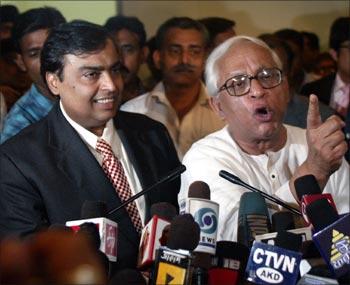
Is it the intermittent strikes or the never-ending political turmoil, is it the 32-year-old Left Front 'rule' or the laid-back work culture of the state -- it is difficult to ascertain what plagues the West Bengal economy that is not really showing much sign of improvement.
Like a head that is growing at a much faster pace while the body falls far behind, there is a large portion of India which is being left out of the process of 'growth'.
This body comprises millions of hungry, dispossessed, displaced people, the new outcasts, on whose life no light shines.
Statistics tell us that a large chunk of these people resides in West Bengal.
What's actually wrong with West Bengal's economy? Which factors led to the dismal state of the state's financial structure?
Let us delve into the issue a bit deeper. Read on. . .
. . .
With inputs from Agencies

What Amartya Sen has to say
In an Indian Express report published early this year, Nobel Laureate Amartya Sen felt it would be interesting to find out why in spite of a stable government for three decades, West Bengal remains a 'mid-level' performing state in terms of public programmes -- health, education and other sectors.
"We have to investigate and find out. If someone had predicted the history of 21st century, he would have said the state would have been leading in IT services in the country. But it is not so," said Sen, while releasing a report on Integrated Child Development Services in the state.
Sen, however, said it is not only the governance that could be at the core of it, but other issues like nature of society and its dynamism also determine the success of public initiatives.
In a column published in The Telegraph a couple of years ago, Sen wrote: 'My support for the general economic strategy of industrialisation of the government of West Bengal cannot but be combined with questions about the importance of democratic values.
'I believe I am right in claiming that more practice of government by discussion would have not only enriched and improved the process of economic decision-making, it would have actually led to better economic plans and better translation of the general strategy of industrialising -- or re-industrialising -- West Bengal.'

Tatas' exit from Singur a non-issue?
In an interview to rediff.com, economist Abhirup Sarkar said that the departure of the Tatas from Singur did not have much impact on the people of the state.
A huge number of factories in Bengal suffered closure because of Left-backed unions' movements. The people of the state were seething with discontent. They refused to risk their present for an uncertain future.
"The Left failed to understand what the people wanted. In their mad and illogical rush for industrialisation, they could not come up with an effective measure to strike a balance between agriculture and industry," Sarkar said.
What went wrong with brand Buddha?
Explaining the reasons for the declining image of West Bengal Chief Minister Buddhadev Bhattacharjee, Sarkar said, "He is a man of positive intention. He is pro-industrialisation and has a lot of aspirations about improving Bengal. But we must realise that the Left Front was enjoying its power in Bengal for more than three decades without paying any attention to industrialisation.
"Soon after the term 'Brand Buddha' was coined and the process of industrialisation set foot in the state, veteran Left leaders started saying that the farmers were no longer interested to stay in the villages.
Here too, the Left leaders committed a mistake. They failed to realise that it were the affluent farmers, say, hailing from the Bardhaman district, who aspired to come out of the villages but the marginalised ones belonging to Purulia or Bankura districts did not want to leave their places of origin.
Hence, the 'dream of industrialisation' appealed to only a handful of people, the so-called creamy layer; it had hardly any appeal for the masses.'
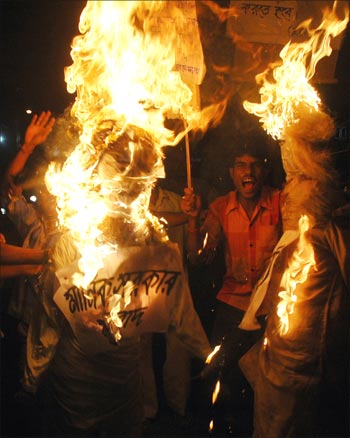
Blind nepotism, another folly
Blind nepotism too dealt a severe blow to the state's economy, said Sarkar. "Soon after industrialisation was initiated, only the Left loyalists won important contracts and deals. New factory owners needed to buy necessary materials from syndicates run by the Left's 'own people'.
"In fact, when the Nano factory was being built in Singur, insiders informed me that often materials had to be bought at thrice or four times the original price.
"Isn't it natural, therefore, that people grew tired of such an industrialisation which brought the benefits to only the Left supporters?" said Sarkar.
Bengal's economy reels under huge debt, he informed. About 97 per cent of the state's revenue is spent on paying interests for loans and also for salaries. The rest 3 per cent is used for development. It is too meager an amount. No wonder, therefore, the infrastructure of the state is in a shambles.
"And the burden of debt is getting bigger with time," Sarkar added.

'Left dragged Bengal into the dark ages'
Sarkar's views are somewhat endorsed by writer and social activist Mahasweta Devi. "For 32 long years, the Left Front leaders have dragged the state back to the dark ages. There has been no improvement whatsoever in the field of education or literacy, health or infrastructure," she said.
"Statistics say that of all the Indian states, our state (West Bengal) only leads in three areas: child mortality rate, violence against women and girl trafficking," she added.
The Magsaysay Award winner corroborated that more than 55,000 factories in the state have closed down, rendering 15 lakh (1.5 million) people jobless.
"There are millions of registered unemployed at the employment exchange. "In primary education, our state ranks 33rd, trailed only by Bihar and Jharkhand," she added.
"In Bengal, a meagre 27.9 per cent of the population gets filtered drinking water whereas in Maharashtra, this figure stands at 78.4 per cent and in Tamil Nadu 84.2 per cent. It's a sad state of affairs," she said.
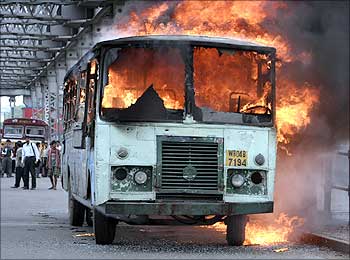
Poor FDI flow
Despite the promise West Bengal held, given its excellent educational institutes, skilled manpower, etc, not much foreign direct investment poured into the state.
Political analysts and observers are of the opinion that militant unionism and political turbulence have mostly been responsible in driving investors -- domestic and foreign -- away.
The recent departure of Tata Motors' Nano factory from Singur was a major blow to the state's hope of gaining FDI.
"Those intending to put money in the state often backtrack at the last minute taking into account the unfriendly nature of the workers' unions along with other political disturbances," they say.
Moreover, red-tapism and associated corruption make matters worse.
Bengal bandhs = Rs 11,000 crore loss!
According to a recent Assocham report, frequent bandhs cause the state to lose 12.5 lakh (1.25 million) mandays in 2006, the year for which data about manday losses have been calculated by different state governments.
In the same period, Andhra Pradesh registered manday losses of 240,000, Rajasthan saw 130,000 mandays being lost, and Tamil Nadu lost 70,000 mandays.
In 2006, Tamil Nadu topped the strikes' list, having called 50 bandhs, followed by Bengal (29), Gujarat (23), Andhra Pradesh (18) and Haryana (14).
As for wage loss because of bandhs, Bengal topped this list, registering a total loss of Rs 35.8 crore (Rs 358 million), followed by Andhra Pradesh with Rs 26.3 crore (Rs 263 million), Karnataka with Rs 13.2 crore (Rs 132 million) and Tamil Nadu with Rs 14.9 crore (Rs 149 million).
A parallel survey done by West Bengal Applied Economic Research for 2007 and 2008 had a similar story to tell. According to it, mandays lost through disruption in Bengal stood at over 30 lakh (3 million) in 2007 and 19.5 lakh (1.95 million) last year.
The figure assume more alarming proportions if one takes into account the fact that there have been more than a dozen bandhs in the past 39 months, excluding those in pockets like the hills and the forests.
Loss incurred by these bandhs would jack up the total loss incurred by West Bengal because of strikes to Rs 11,000 crore (Rs 110 billion) since August 2006.
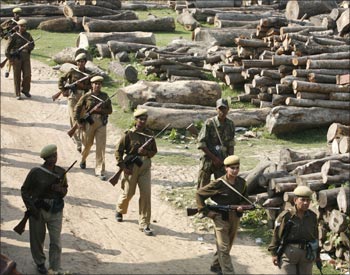
Multinationals' entry
Multinationals have been blamed for attacks on and exploitation of the farmers in rural Bengal. The state -- which opposition political parties allege is compicit with the moneybags -- has already seen the ugly episodes at Singur and Nandigram.
Farmers, small businessmen and traders fear that multinational giants want to take control of the entire retail sector: from production to distribution. This has struck terror in their hearts. These traders believe that unless the state government draws up a comprehensive plan to rehabilitate the small business owners, the unorganised retail sector in Bengal would suffer a quick and painful demise.
Economists sad that West Bengal ranks third among states the country in the number of small retail shops. There are between 30 and 45 lakh (3-4.5 million) small shops in the state. About 4 persons earn their livelihood from each shop. An estimated 2 crore (20 million) people directly dependent on these stores for their livelihood.
This number is much larger if people who are both directly and indirectly dependent in this sector can be taken into consideration.

SEZs=special exploitation zones?
Special economic zones, or SEZs, which are coming up in different parts of the country are in essence production zones for consumer goods.
It is widely alleged that SEZs exploit the available natural resources and encroach on the arable areas, resulting in the displacement of farmers and indigenous people.
Despite protests by the displaced farmers, the state government has not been able to come up with any rehabilitation formula.
This is a problem that plagues many states in the country, West Bengal more so.

Bengal woos IT firms
In the first five years of chief ministership, Buddhadev Bhattacharjee focussed on the services sector. He got Wipro and hoped for Infosys, while TCS expanded. Azim Premji thought he was the best chief minister, Ratan Tata reposed full faith in Bhattacharjee and brought Nano to Bengal from Uttarakhand.
There were quite a few other success stories as well. JSW Steel's 10 million tonne steel project is probably the only mega steel project to have the land, mines and all clearances including SEZ status.
Bhattacharjee also recently stepped in to allocate land to Wipro and Infosys. Both the companies were earlier offered land at an IT township called Kolkata Links located near a spa resort called Vedic Village which erupted in controversy, involving the state government as well.
Why did the Bengal chief minister woo the IT sector? The idea was that IT firms primarily hired white collar employees who are not given to unionism. Bengal also has a healthy supply of highly skilled manpower, given its tradition of stressing on the importance of education. Thus, for the IT industry finding the right people has been easy in the state.
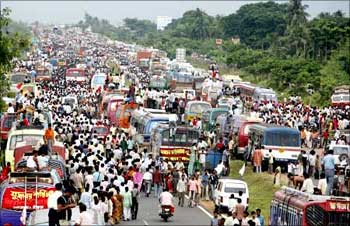
Death of small businesses and job cuts
The takeover of small businesses by large conglomerates has severe and far reaching effects. Smaller businesses cannot afford to remain competitive in the face of price competition by larger corporations.
The effects are also felt by the different layers of middlemen -- the rickshaw pullers and the van drivers who transport the goods, producers, businessmen and salesmen, who are part of the intricate network of people involved in the small-scale industry.
Employment opportunities too suffer a jolt. Currently, in a normal 100-square foot store, about four people, including the owner, are employed on an average. Hundred such stores provide livelihood to at least 300 people. However, only 25-30 people are employed by a 10,000-square foot shopping mall.
In addition, people who are employed by larger stores create an income disparity, as they receive almost double the wages in addition to the many facilities provided by their employers.
Therefore, if the organised sector can take control of even 20 per cent of the small business market, more than 1 crore (10 million) people will lose their jobs, while only 1,80,000 people will find employment.
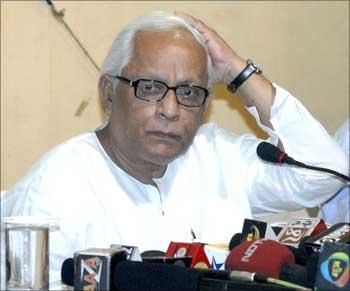
Increasing rate of farmer suicides
Economists fear that encroachments by large corporations affect the food security of a large segment of the country's population.
India has about 11 per cent of the arable land of the whole world, and produces the greatest variety of crops. India leads the world in the production of vegetables and fruits, and comes only third to the United States and China in foodgrain production.
The entry of the multinationals leads to contract farming. There is a misconception that as a result of this, the farmers receive adequate compensation. But few realise that this would hardly be the case.
What actually happens is that the farmers lease out the lands and the MNCs lease in and dictate the crops. The seeds, fertilisers and pesticides in that case also belong to the agents. The farmers in effect become bonded labourers.
If the crop fails, the farmers are forced to default on their loans. This leads to a great rate of farmer suicides.
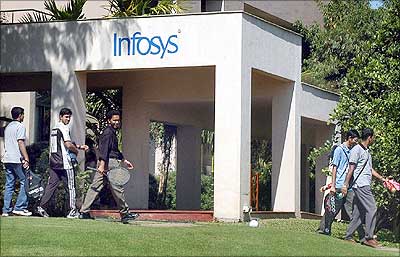
Postscript
A recent Business Standard report stated that observers feel that though the Bengal chief minister's intentions were good, he did not know how to handle the potential problems arising out of the highly emotive issue of land acquisition from farmers and allowed things to drift.
"If Bhattacharjee's initiatives have received a jolt, so have the reforms planned by the party, though the hardliners relegated to the backseat have found their voice," they said.
Be that as it may, the state which has tremendous potential to lead India's march towards becoming an economic superpower continues to languish due to political mismanagement. In the bargain, the people of the state are suffering, especially the poor.
Bengal does have many schemes that have been launched with the intention of ameliorating the condition of the people. These schemes aim at enhancing the infrastructure of the state, giving a boost to its agriculture sector, proving the much-required thrust in the development and social sectors, apart from keeping its education sector robust.
However, how or whether these schemes would be implemented is something there is not much clarity on.
Repeated attempts by rediff.com to get an official response to what ails the economy of West Bengal were met with silence from the government.